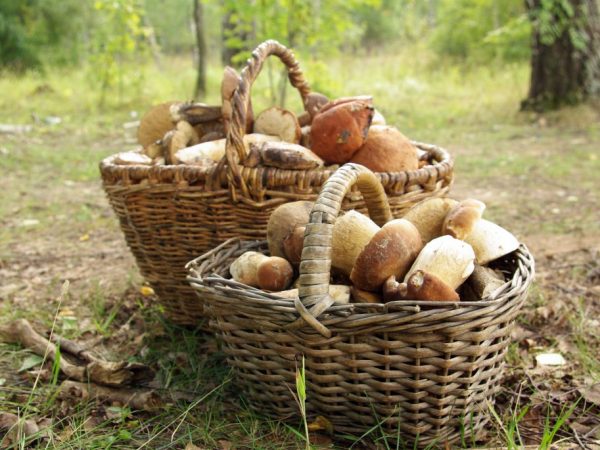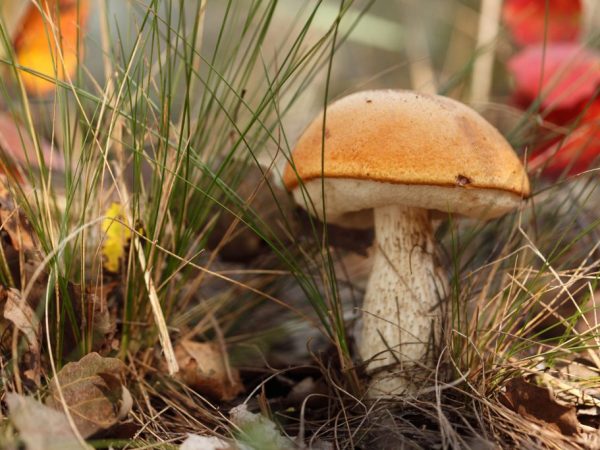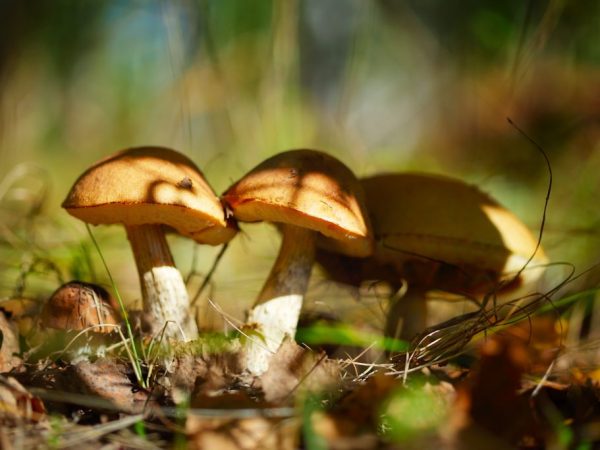What mushrooms can be collected in the south of the Moscow region
The mushroom world is great in its diversity. Throughout the season, mushrooms in the south of the Moscow region delight fans of "forest fishing" with their choice. But before going into the forest, you need to find out which individuals are edible and which are poisonous, and how best to cook this or that species.

Mushrooms in the south of Moscow region
general characteristics
Each mushroom has its own qualities and taste. According to the degree of edibility, forest mushrooms are divided into 4 groups:
- edible;
- conditionally edible;
- inedible;
- poisonous.
Without heat treatment, only representatives of the group of edible species (russula, champignons, etc.) are suitable for food.
Conditionally edibles have a bitter taste. They are soaked before main cooking. The third category, which includes inedible mushrooms, requires special attention: they are thoroughly washed, changing the water several times, soaked and only then cooked.
Poisonous mushrooms, which are part of the fourth group, are strictly forbidden to eat. To remove their toxins from the fruiting bodies completely at home is not only difficult, but almost impossible. Therefore, it is better not to risk it. Some of them cannot even be touched with your hands. The poison of the pale toadstool penetrates the skin and is transmitted into the bloodstream, after which severe poisoning occurs.
Flavor classification
The taste value of edible and conditionally edible species is determined on a different scale.
On the 1st step, or as part of the 1st category, there are mushrooms with a pronounced taste and aroma: white mushrooms, boletus mushrooms, milk mushrooms, mushrooms and fawn
The second category includes mushrooms that are less aromatic, but just as tasty. For the most part, these are dense and tasty boletus, noble boletus and aspen mushrooms, Polish mushrooms similar to porcini and all kinds of champignons.
All representatives of the 3rd category have an average taste, which is not in great demand among mushroom pickers. However, an exception can be made for honey agarics in this regard - they are the desired prey. Honey mushrooms are more often pickled or salted, russula are fragile and brittle, more suitable for cooking soups, Moss and morels are more suitable for pates and cold snacks.
Conditionally edibles belong to the 4th flavoring level. They are specific and require careful and lengthy pretreatment. This category includes: milk mushrooms, oyster mushrooms, hedgehogs, part of honey agarics, cobwebs, pink forest champignon, dung beetles, marsh oil can, part of moss, etc.
Types of mushrooms in the Moscow region
For the south of Moscow and the Moscow region, the harvest season begins with the arrival of the first spring heat, when the temperature is stable, reaches + 15 ... + 17 ° C and the air is saturated with moisture.
Edible
As soon as the snow melts, there are:
- morels;
- lines;
- May mushrooms;
- tinder fungus;
- field mushrooms;
- birch sponges.

In the south of the Moscow region, you can find many varieties of mushrooms
In the summer and autumn seasons, a large group of tasty and healthy mushrooms appears:
- white;
- mushrooms of different types;
- waves;
- aspen mushrooms;
- mushrooms;
- boletus;
- milk mushrooms;
- waves;
- flywheels.
It is simply impossible to list all the varieties in the south of the region. Each species chooses a certain type of trees, terrain and soil for the formation of mycorrhiza.
Mushroom places in the south of Moscow and the Moscow region are rich in mushroom harvests until the onset of cold weather. Before frost, lucky mushroom pickers find whole families of honey agarics on tree trunks, in withered nettles and on mossy stumps. They are suitable for drying and pickling, making delicious first courses.
Volnushki, black milk mushrooms and russula grow in the forests near Moscow everywhere. Coniferous and mixed forests in the south of the region are the usual habitats of Polish mushrooms, boletus and boletus.
Inedible and poisonous
All poisonous species should be recognized at first glance and understand how they differ from those suitable for food.
The inedible and poisonous mushrooms of the Moscow region include:
- Satanic;
- fly agarics;
- death cap;
- yellowing or orange champignons;
- bilious.
The poisonous pale toadstool is often confused with the mushroom. They are too similar in appearance. But the toadstool has a characteristic "skirt" on the leg located very high, almost under the cap and the flesh does not change color on the cut. Toxins from pale toadstools are characterized, in addition to significant danger, by the high permeability of the skin and are absorbed into the capillaries located directly under the skin. Therefore, you should not tear it with your hands or step with bare feet.
The satanic mushroom looks like a white one, but it is revealed by a barely noticeable black mesh on the leg and a very thick leg.
The gall mushroom is also similar to the white one. Only on the cut does its pulp turn yellow and the taste is bitter, unpleasant. It is difficult to remove the bitterness of the gall mushroom, so one piece of it can ruin the whole dish.
Mushroom places

There are many mushroom places in the Moscow region
In order not to wander in search of mushroom spots for a long time, it is better to study the forest map of Moscow and the Moscow region before the hike.
A kilometer from the village. Mitkino and Dachnaya station, there is a good forest area with meadows of champignons and russula. For s. Nazarevo, if you walk along the Bolshaya or Malaya Vyazemka rivers, mushroom pickers pick up boletus and mushrooms.
From the Khlyupino platform there is a train in the direction of the village. Raevo and Alyauhovo. A dense forest comes close to them, in which all kinds of honey agarics grow in a windbreak throughout the season.
There are many good places along the Zvenigorodskaya line. If you take a train on the Skorotovo platform and get to Dudino, you can find different types of mushrooms right next to the railway.
If you walk 3 km from the Sushinskaya platform to the south, a huge forest area will open up (this is the Kiev direction), in which no one will be left without mushrooms.
2-3 km from the Teatralnaya and Sadovaya platforms there is a settlement. Makeikha and Trufanovka. Behind them there is a forest with good fertile soil, where mushroom pickers collect honey agarics, russula and champignons all season. White and aspen mushrooms are often found.
The best places are considered to be the area near the river, which flows near the Petelino station, near the villages of Tatarka and Ivonino.
A little further, in a forest near the village. Klopovo, a lot of waves, morels, lines and mushrooms.
Near the village. Svitino across the Desna River, mushroom pickers every year collect full baskets of mushrooms, tinder fungi, May mushrooms and birch sponges.
Benefit and harm
Mushrooms are saturated with vitamins, microelements and amino acids important for humans.
Regular consumption of them helps to stabilize blood pressure, blood sugar levels, stimulates brain activity and boosts immunity.
Many species are used in medicine and pharmaceuticals to create medicines.
Traditional healers widely use them to create tinctures, ointments and decoctions that successfully help with various diseases.
But there are also harmful properties - they actively absorb all the toxins from the air and soil, and then these compounds enter the Pushcha. Therefore, it is better not to pick mushrooms near factories, residential areas and busy highways. Otherwise, there is a great risk of poisoning.
Irina Selyutina (Biologist):
Different types of mushrooms are capable of accumulating certain heavy metals in their fruiting bodies, i.e. we can talk about the selectivity of this process. So, russula, milk mushrooms, some types of raincoats absorb copper from the environment, but champignons and porcini mushrooms absorb mercury. They take radionuclides from the forest floor, for example, radioactive cesium. In the fruiting bodies of young mushrooms, significant concentrations of readily soluble compounds of heavy metals and radioisotopes are found in comparison with old ones. Most of them are deposited in caps, especially in the hymenophore (its type is not important). Over time, in the presence of constant environmental pollution, these elements begin to accumulate in the vegetative body (mycelium). It was found that more heavy metals are found in symbiont fungi in comparison with wood-destroying saprophytes.
If you are picking mushrooms in areas with a high anthropogenic load, and hence the corresponding level of pollution, the chances of removing toxins from the harvested mushrooms to an acceptable level are not great.
Mushrooms are difficult to digest due to the high content of chitin, which is especially abundant in their legs. Because of this property, mushrooms are not recommended for people suffering from diseases of the gastrointestinal tract, for children under 7 years of age.
Conclusion
In the Moscow region, on the south side, there are many excellent mushroom spots. To enjoy a walk in the woods, combined with a "quiet hunt", be sure to take precautions, do not pick poisonous mushrooms and carefully examine the harvest already harvested.



